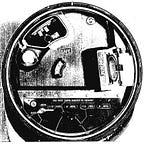Iran’s Drones Are Back in Iraq
They weren’t gone for very long
by ADAM RAWNSLEY
In recent years Iran’s drones have buzzed into action over Israel, Syria and Lebanon. And now Iranian drones are returning to the scene of their birth—the skies of Iraq, where Tehran’s flying robots saw their combat debut during the 198os Iran-Iraq war.
Iran’s Revolutionary Guard Corps is deploying the Mohajer-4 surveillance drone and its cousins—descendants of the country’s first Mohajer-1—in its bid to halt Islamic State jihadists in Iraq.
But Iran is also using its drone fleet for more than just military purposes. In addition to conducting surveillance, Iran’s drones are also a political tool, helping Tehran to expand its influence in Iraq.
The surge in drone operations reportedly began almost as soon as Islamic State captured the city of Mosul in northern Iraq in June 2014. In contrast to the United States’ own initial hesistancy to help Iraq, Iran moved quickly to display its support.
Shortly after Mosul’s fall, The New York Times reported that Iran had already sent a fleet of drones, in addition to other assets, to the Iraqi capital to provide overwatch for the cities and towns that surround Baghdad.
Iranian forces reportedly parked ground control stations at Baghdad’s Al Rasheed air base, flying Ababil drones—likely the Ababil-3 series of unmanned aerial vehicle that frequently appear in Syria—around the city’s periphery.
As the fight against Islamic State has escalated, Iran’s Revolutionary Guards Corps is also sending in Mohajer-4s to augment Tehran’s advisers on the ground.
This week, Islamic State released images of an Iranian UAV—a Mohajer-4, apparently—that had crashed near Kirkuk in northern Iraq. The wreckage sports the Mohajer’s iconic boxy frame and four cylinder propeller engine.
The serial number format—a prefix of “A041” followed by a two or three digit number that specific to the individual aircraft—is customary for Mohajer-4 UAVs.
The drone that went down in Kirkuk also has an “A/B” stamp on its label that was also evident on Mohajer-4s that Iran displayed in August 2014.
To be sure, Iranian forces in Iraq have flown Mohajer-4s before, as recently as November.
That month, Twitter user @green_lemonnn found photos — on the Facebook profile of an Iraq-based Islamic State member, reportedly — of a Mohajer-4 that went down near Jalawla, Iraq. Islamic State itself also released pictures of the UAV.
A Mohajer-4 with the serial number A041–112 last appeared in September 2010 on a parade float during Sacred Defense Week, Iran’s annual commemoration of the beginning of the eight-year war with Iraq.
While there is limited evidence of repeating serial numbers, they have appeared on Ababil-3s in Syria. No such evidence is apparent for the Mohajer-4s.
The Kirkuk aircraft was likely part of a larger IRGC contingent in the region, working alongside Kurdish Peshmerga forces to combat Islamic State. Iran’s shadowy covert Qods Force commander Qassem Soleimani was reportedly present in Jalawla at the time directing combat forces.
Reporting suggests that the Iranian UAVs scouted out targets for bombing runs by Iranian F-4 Phantom fighters that took place just days after the pictures of the downed Mohajer-4 surfaced.
The Mohajer was not in Islamic State custody for long, however. By mid-December, pictures appeared on social media showing a Peshmerga soldier sitting on a Mohajer-4 with the same serial number, bent antenna and port-side wing damage as the UAV that crashed in Jalawla.
That an Iranian Mohajer crashed in Jalawla is something of a historical irony, as it’s not the first time the city has played host to a downed Iranian drone.
In February 2009, back when U.S. forces were still operating in Iraq as part of Operation Iraqi Freedom, American troops captured an “almost completely intact” Iranian UAV—complete with American-made parts—that parachuted down near the city.
In addition to the Mohajer drones, Iran has also exported its more basic Yasir drone, a knockoff of the American Boeing Insitu ScanEagle, to one of its proxy groups in Iraq.
Harakat Hizballah Al Nujaba, an Iranian proxy group in Iraq, released pictures in late December of a Yasir in its possession, decorated with stickers of its logo. The group claimed to have deployed the Yasir in the course of fighting against IS in Diyala province.
Phillip Smyth, a researcher at the University of Maryland who tracks Shia militia activity, has closely followed Harakat Al Nujaba’s rise as a front group for another Iranian-backed Iraqi proxy, Asa’ib Ahl Al Haq.
Smyth says that Harakat Al Nujaba’s photo op with Iranian drones is part of a larger Iranian media push to promote its Iraqi client.
“The fact that you’re seeing the drones going to them, there’s been a huge promotion for some of these newer special groups,” Smyth tells War Is Boring. “Nuajaba is one of them and that’s why you’re seeing this.”
That political symbolism is also key to understanding Iranian drones’ role in Iraq. The UAVs, like Iran’s covert troops and warplanes, aren’t just a material contribution to Baghdad’s fight against Islamic State.
They’re also a symbol that Tehran is willing and able to deploy its latest and, relatively-speaking, greatest military hardware in order to boost Iran’s political allies in Iraq.
